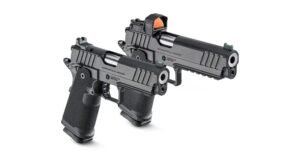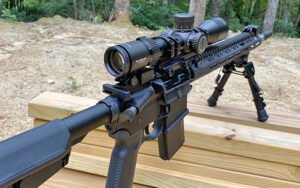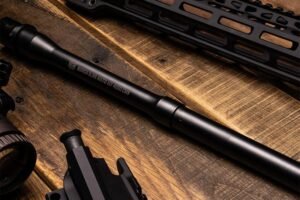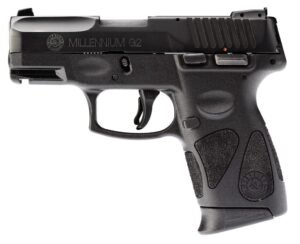Smith & Wesson CSX Review
Our CSX review shows that Smith and Wesson hasn’t just created another Shield variation to add to the high capacity pocket pistol market.
While it used to be that sacrificing size meant sacrificing capacity, in the land of the new micro compacts, that rule is dead. Like other high capacity micro 9s, the CSX makes it possible for a gun owner to have one handgun that can be easily concealed, yet has enough capacity to not feel handicapped when compared to larger pistols.
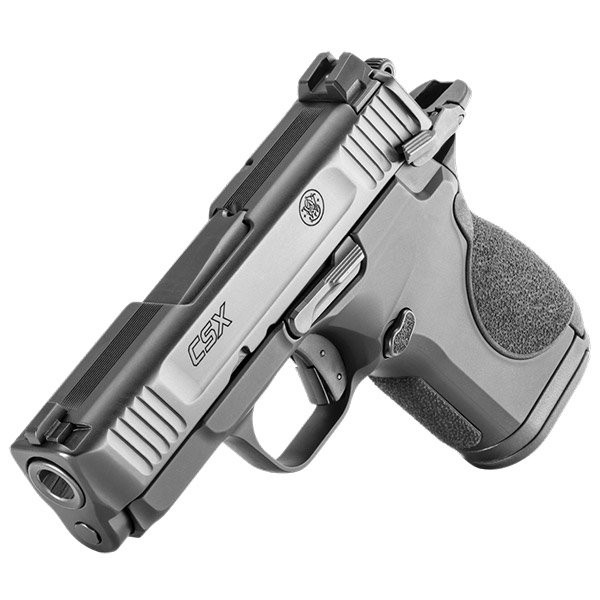
Our CSX Review
With the release of the Shield Plus, Smith & Wesson followed Sig, Springfield Armory, and others into the increasingly crowded market of high capacity pocket 9mm subcompacts. Now S&W has added a new arrow to their quiver with the CSX, one that’s been winning accolades throughout the industry for its performance and ingenuity.
At first glance you’d be forgiven for assuming that S&W has simply created another variation of the venerable M&P shield lineup. While that’s partially true, the CSX also makes some pretty big departures.
The frame certainly looks similar to a Shield, but you start to notice the distinct styling and contours of the slide, or how the slide seems to be pushed forward a little more aggressively from the frame than a traditional Shield. Then there’s that beavertail hanging way out there. All very reminiscent of a 1911, and that’s not where the similarities between those two end.
So is it a Shield? Is it a Micro 1911? Well, it’s both.
Upon picking it up, another distinct difference becomes evident. It’s unexpectedly heavier than similar sized and similar looking guns. That’s because unlike most of these new pocket polymer handguns, the CSX is built on an aluminum alloy frame. And while we say “heavier”, that’s not to say it’s heavy, but the use aluminum here certainly adds a feel of sturdiness to this tiny pistol.
The biggest difference between the CSX and most of the new high-cap subcompact 9mm pistols is function. The CSX is a single action, hammer-fired pistol much like modern micro 1911s like the Sig 938 or Springfield 911. This configuration allows for a slimmer slide as well as the short pull common to a single action trigger.
The CSX incorporates a flat-faced trigger design that includes a bladed trigger safety mechanism. Being single action only, you get the crisp, short pull you expect, something anyone who has dealt with double action only micro pistols will surely appreciate. The trigger safety is implemented extremely well, operates seamlessly and is completely unnoticeable as the trigger is operated.
In addition, the CSX includes a 1911-style manually operated ambidextrous safety lever. While many may feel that a manual safety is a potential liability in a defensive scenario, one can understand how an extra layer of safety between a person’s firearm, and say, the curious little hands rummaging around in a purse can help with peace of mind. It’s not a feature found on a lot of small pistols these days, and certainly may appeal to a certain segment of the market.
Additionally, the CSX features a small window at the very back of the ejection port. The old adage that “every gun is always loaded” still holds true, but the ability to visually inspect for a chambered round without moving the slide or otherwise manipulating the firearm is a feature I know I appreciate.
The CSX comes with both a 12- and 10-round magazine. While the 10-rounder fits flush with the base of the grip, the 12-round “extended” magazine incorporates a small insert to fill the space between the bottom of the grip and the baseplate. Quite frankly, the overall difference between the two magazines is almost negligible, making one wonder why they just didn’t go with two 12 round magazines?
While the CSX does not have a truly ambidextrous mag release, the release button can be swapped for a left handed shooter without too much trouble. I much prefer this system to some of the true ambi mag releases out there, as I find there are times I can’t cleanly release a magazine because the button is literally blocked by my palm on the opposite side of the grip (looking at you here, FN).
CSX Ergonomics
Yup, it’s small. As someone who’s used to carrying a Walther PPS single stack 9mm, which at the time of its release was considered to be best-in-class as far as how minimal a subcompact 9mm could get, I’m continually amazed at how these companies have managed to get so much capacity into such small packages.
Put side by side, the double stack CSX is slightly less slim overall (and only in the grip) than the single stack PPS. When laid on top of the PPS, the CSX is dwarfed by my PPS even when using the PPS’ smallest (6 round) magazine. When put next to a standard sized handgun, such as M&P 2.0 as shown below, the CSX’s size difference becomes absolutely obvious. Safe to say, the CSX is highly concealable, yet is capable of offering double the capacity of some single stack pistols in a smaller package.

Despite its diminutive stature, the CSX is extremely comfortable to hold. It’s feels extremely solid, nothing cheap feeling about it at all. The grip fills the palm nicely as it bubbles outwards slightly to make room for increased capacity. Everyone’s hand size is different but I found the extended magazine provided just enough length to allow all four fingers to wrap around the grip. Without it, my pinky finger slipped under the bottom.
While the majority of the frame may be aluminum, S&W has worked interchangeable polymer backstraps into the design to allow a shooter to customize their grip and fit to whatever works best for them. The polymer inserts are textured without being too aggressive. Overall I found the ergonomics of the CSX to be as good as it gets for a subcompact concealed carry piece.
One of the issues micro pistols are susceptible to is that the same extra strong springs they to keep recoil and muzzle rise minimal also make it difficult for some to manually work the slide. Smith & Wesson has incorporated the EZ tab to help to make racking the slide easier, and there seems to be some other aspects of the EZ system in place. Operating the slide of the CSX is easier than many other smaller guns.
The CSX is equipped with standard front and rear dovetail sights. White dots are used to help aid in lining up your site picture. No doubt, upgraded sights of all types will be available.
If there’s one knock against the CSX, it’s that takedown is a bit more complicated compared to other guns out there these days. Anyone who’s field stripped a 1911 will instantly know what’s going on, but those used to disassembling Glocks will find it a bit more complex. It’s not hard to do, but it’s not simple either and will definitely take practice. It also requires the use of a tool, which isn’t ideal. This aspect could be a bit off-putting for some.
It’s also worth noting that the CSX does not incorporate any method to mount a light or laser below the barrel. That’s never been a deal breaker for me, as I’ve always believed that adding a bunch of things to a tiny pistol sort of defeated the purpose, but that opinion may not be shared by everyone. It’s very possible there’s nothing on the market at this point that is small enough to mount there anyway.
At the time of writing this CSX review, MSRP is just over $600, though most local shops (including ours) will have it for less. Like the rest of Smith & Wesson’s lineup, it’s sure to be well supported with accessories and add-ons.
At the Range
We fed our CSX multiple flavors of 9mm ammo, from cheap 115 gr reloads, to high velocity Federal +P HST defense ammo, and even some 147 gr Winchester Silvertip subsonic hollow points. The CSX happily chewed through it all without any issues.
Like most micro 9mm pistols, I expected the CSX to be snappy, though maybe less so than others given the full metal frame construction. But I must admit I was not prepared for just how smooth this little gun shoots. Whatever dark bargain Smith & Wesson struck in order to create a 9mm pistol this small with so little recoil, it was worth it. I’m not exaggerating when I say that the CSX shoots with a lot less recoil and muzzle rise than some much larger 9mm polymer handguns.
Ringing a 6-inch steel gong from 5 yards with quick double taps was surprisingly easy. The extra two ounces of weight from the aluminum frame helps to tame the recoil, and get get you back on target that much faster. From 10 yards, there was no issue ringing the steel. From 25 yards, with careful aim, again, the bullets went exactly where they were supposed to. The occasional miss was certainly the fault of me and not any inherent accuracy problem of the CSX.
To be clear, nothing we did amounted to a torture test, but based on experience, I have no issue saying the CSX shows excellent potential as reliable and accurate pistol, exactly what you’d want from a daily concealed carry or home defense. Those out there who have run hundreds or thousands of rounds through theirs agree.
CSX Summary
The CSX stands out from the crowd with features and flourishes not found on many competitors. While some might find it a bit cumbersome to field strip, that one disadvantage is far outweighed by the many pros that matter most when it counts. The CSX is easy to handle, easy to shoot, and offers additional peace of mind with safety features not often found on ultra compact handguns.
We highly recommend the CSX for anyone looking for a concealed carry pistol that can also double for home defense.
Springfield Armory Prodigy Review
The Springfield Armory Prodigy takes the proven 1911 platform and enhances it with double-stack capacity and a performance-driven feature set.
What is a RECCE Rifle? Meet the Longshot
US Navy Seals developed today’s Recce Rifle concept in the early 90s to bridge the tactical gap between their CQB M4s, and their larger and heavier precision rifles.
5.56 NATO VS .223 WYLDE
People new to the AR-15 can be forgiven for believing that they’re only made to fire the 5.56 NATO cartridge – the same that militaries around the world use (the NATO designation is there for a reason). They’ve also likely heard that for all intents and purposes, the 5.56 NATO and .223 Remington cartridges are pretty much…
AR-15 Pistol vs SBR. What’s the difference?
The laws that determine what takes an AR-15 from a pistol or rifle into NFA territory can be both fascinating and headache-inducing. But by keeping few rules of thumb in mind, it’s not as bad as it might seem.
Taurus G2C Review: Amazing Value or Too Good to be True?
Taurus G2C Review The Taurus PT-111 G2 has undergone a few minimal internal improvements and cosmetic changes and released back into the wild as the Taurus G2C. With many retailers offering this subcompact for around the $200 mark, it’s certainly turning a lot of heads and getting a lot of interest. Of course, one of the…


